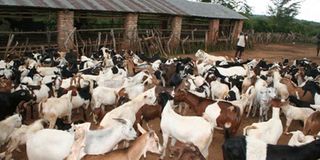Majority of households in Uganda depend on livestock-UBOS survey

Statistics shows that rearing livestock is an activity carried out by most farmers in Uganda. With proper policies and investments, the sector can be boosted to improve the livelihoods and incomes of the farmers. FILE PHOTO
New statistical data from Uganda Bureau of Statistics (Ubos) reveals that most households in Uganda depend on livestock for their livelihoods.
This was contained in a report, Better Data for Better Livestock Polices, which was released during a dissemination workshop to mark Africa Statistics Week. It indicates that 52 per cent of households, which represents 19 million people keep livestock.
In terms of income, computed statistics indicates that animal products contribute 17 per cent to their income. In the rural areas, livestock contributes 18 per cent of income while in urban areas, it is 12 per cent.
Increase in demand
Though there are many livestock farmers in the rural areas, which constitutes 91 per cent representing 2.9 million families or 17.3 million people, Ubos data shows that most are poor.
“If livestock farmers utilised extension the total aggregate household income would increase by more than $260m per year with corresponding reduction in poverty levels. The value addition of livestock would increase by almost 70 per cent,” noted the director of agriculture and environment statistics at Ubos, Patrick Okello, in his presentation.
A senior official in Ministry of Agriculture, Animal Industry and Fisheries (Maaif) Joseph Sserugga pointed out that demand for livestock products will increase four times in the next decade.
“The sector will become the largest contributor to agriculture in the coming year decades (such as industrialised economies),” he said.
Speaking on the policy recommendation of a dual approach to livestock sector policies and investments, he said these should ensure that livestock farmers get access to extension services and basic production inputs.
“Currently, only 19 per cent of the livestock farmers utilise extension services, healthy and well-managed animals can significantly contribute households’ income food, insurance, draft power, transport, dung, among others,” he said.
“There is little need to invest resources for ensuring access to output markets for households keeping one or few animals as they sell livestock products occasionally to the market.”
Appreciate the sector
Sserugga explained that policies and investments should ensure 10-20 per cent of livestock keepers—those that can set up profitable businesses around their animals—get access to input and output markets.
There is growing demand for animal-source foods, improved breeding, animal health, feeding strategies can significantly boost productivity, which is low.
Since livestock contributes a reasonable percentage of the livestock farmers, regular access to competitive output markets is critical for livestock keepers to set up a profitable business around their animals.
“The National Panel Survey livestock data, as disseminated, provides an unprecedented opportunity for Maaif to appreciate the smallholder livestock sector in Uganda,” Sserugga said.
Since data collection during period is a little difficult, Ubos says it will intensify the use of Geographic Information System (GIS) in long-term surveys so as to have more accurate data on various surveys it often carries out, for government bodies to make policy decisions/plans.
GIS is an information system for creating, maintaining, managing and using geographic knowledge. GIS is a complete platform for working (editing, data management, mapping, spatial analysis and visualization) with geographic information which plays a great role in surveys.
Ben Paul Mugyereza, the Ubos executive director, said Uganda has made enormous strides in embracing GIS/ Spatial Data Infrastructure (SDI) technologies since early 1990s.
“With increasing availability of special data and provisions for GIS infrastructure in form of affordable software and hardware, the GIS practitioners and users have likewise increased in number and utilisation,” he said.
Fully embraced
Mugyrereza said Ubos has also continued to provide GIS data through the long-term surveys programme and uninterrupted decennial population and housing censuses, pointing out that the bureau has afforded to maintain the availability of geo-statistical information in a reliable, accurate and timely manner to all government and non-government agencies without discrimination.
“In its continued commitment to make statistics a public good, the bureau serves and disseminates geographic information products in form of print, web-based, standard core datasets, and other customised on request from ministries, agencies and departments, academia, private sector, NGOs, and other users,” he said.
Globally, GIS are one of the fastest growing computer-based technologies of the past two decades in data collection.
In relation to what is happening globally, Mugyrereza explained: “International practice shows that GIS are one of the effective tools to use to coordinate statistical data capture, processing analysis and dissemination to support decision –making process at all levels of management, hence GIS application has been fully embraced by the bureau as a corporate function critical in statistical data capture and production processes, in line with Ubos’ mandate.”




